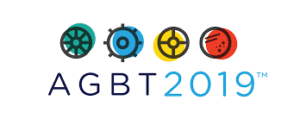 The PacBio team was honored to have the opportunity to give several talks at this year’s Advances in Genome Biology & Technology conference. If you weren’t able to be there, we’ve got you covered with videos and highlights.
The PacBio team was honored to have the opportunity to give several talks at this year’s Advances in Genome Biology & Technology conference. If you weren’t able to be there, we’ve got you covered with videos and highlights.
In a plenary session, Marty Badgett, senior director of product management, gave attendees a look at the latest results using the HiFi reads with the circular consensus sequencing (CCS) mode as well as a sneak peek at data from our soon-to-be-released Sequel II System. As he demonstrated, HiFi reads cover the same molecule many times, delivering high consensus accuracy (Q30 or 99.9%) at long read lengths.
This mode now works with fragments as long as 20 kb, as we showed in a recent preprint. Badgett offered several examples where this is useful, such as pharmacogenomic gene analysis and resolving metagenomic communities. He also updated attendees on our Iso-Seq method, which can now segregate transcripts into haplotype-specific alleles using a new tool called Iso-Phase.
Of course, the big highlight of the talk was a look at early data from the Sequel II System, which delivers approximately eight times the data of the Sequel System. Badgett showed that read length distributions and many other factors are essentially the same as the current system, but that the new model has improved raw read accuracy, taking eight passes around a molecule instead of ten to get to Q30 accuracy in CCS mode. He also presented results from Iso-Seq analysis, plant genome assembly, and continuous long-read mode. The Sequel II System is in five early access labs and will be commercially released in the second quarter of this year.
Later, CEO Mike Hunkapiller and Principal Scientist Jason Underwood gave talks in the much-anticipated technology session. Hunkapiller focused on the use of HiFi reads for comprehensive genomic analysis, offering examples such as the sequencing of a Genome in a Bottle reference sample, which concluded with Q48 accuracy, 18 Mb contigs, and clearly phased haplotypes.
That work also entailed variant analysis — Hunkapiller noted that SMRT Sequencing delivered good recall and precision for deletions and insertions — which performed best using DeepVariant from Google to model the data. The results showed that several seemingly high-confidence variant calls from previous analyses of the same sample were incorrect and added a significant number of new variants to the catalog.
Underwood spoke about single-cell isoform sequencing (scIso-Seq), focusing on a collaborative project with the labs of Evan Eichler and Alex Pollen. For this effort, scientists used Drop-seq sample prep and then loaded cDNA products onto the Sequel System. Results from a barnyard experiment using mouse and human cells as well as from cerebral organoids showed that this approach could deliver cell type-specific gene expression data. Underwood also presented data from the Sequel II System comparing chimp and human organoids, resulting in information for about 14,000 unique genes with important insights for post-transcriptional gene regulation, transcription start sites, and more.
Finally, Primo Baybayan, our Director of Applications, presented a poster entitled ‘A high-quality de novo genome assembly from a single mosquito using PacBio sequencing.’ In the poster, a modified SMRTbell library construction protocol was used to generate a SMRTbell library from just 100 ng of starting genomic DNA. The sample was run on the Sequel System, generating, on average, 25 Gb of sequence per SMRT Cell with 20-hour movies, followed by diploid de novo genome assembly with FALCON-Unzip. The resulting assembly had high contiguity (contig N50 3.5 Mb) and completeness (more than 98% of conserved genes are present and full-length). This new low-input approach now puts PacBio-based assemblies in reach for small highly heterozygous organisms that comprise much of the diversity of life.
Many thanks to the AGBT organizers for inviting our team to present this exciting science!
March 12, 2019 | Events + conferences